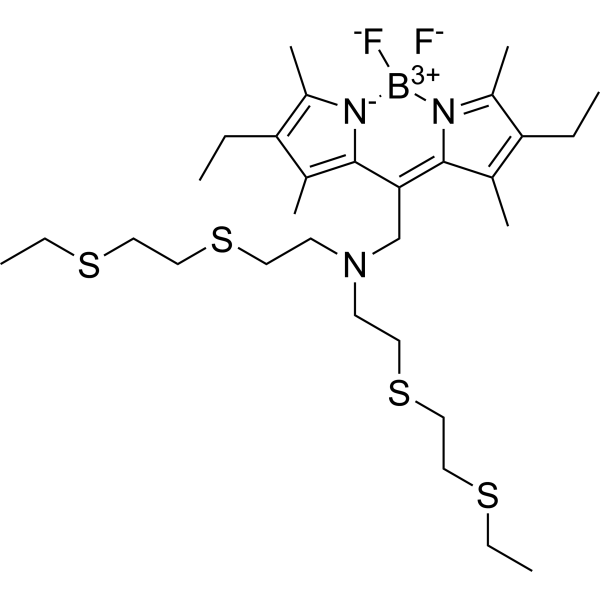
Coppersensor 1
CAS No. 874748-20-6
Coppersensor 1( CS1 )
Catalog No. M28340 CAS No. 874748-20-6
Coppersensor 1 is a boron dipyrromethene-based fluorescent sensor for selective and sensitive detection of copper(I) ions (Cu + ) in biological samples. Coppersensor 1 can be imaged using any type of fluorescence microscope, including epifluorescence, confocal and multiphoton.
Purity : >98% (HPLC)
 COA
COA
 Datasheet
Datasheet
 HNMR
HNMR
 HPLC
HPLC
 MSDS
MSDS
 Handing Instructions
Handing Instructions
| Size | Price / USD | Stock | Quantity |
| 5MG | 205 | Get Quote |


|
| 100MG | Get Quote | Get Quote |


|
| 200MG | Get Quote | Get Quote |


|
| 500MG | Get Quote | Get Quote |


|
| 1G | Get Quote | Get Quote |


|
Biological Information
-
Product NameCoppersensor 1
-
NoteResearch use only, not for human use.
-
Brief DescriptionCoppersensor 1 is a boron dipyrromethene-based fluorescent sensor for selective and sensitive detection of copper(I) ions (Cu + ) in biological samples. Coppersensor 1 can be imaged using any type of fluorescence microscope, including epifluorescence, confocal and multiphoton.
-
DescriptionCoppersensor 1 is a boron dipyrromethene-based fluorescent sensor for selective and sensitive detection of copper(I) ions (Cu + ) in biological samples. Coppersensor 1 can be imaged using any type of fluorescence microscope, including epifluorescence, confocal and multiphoton.(In Vitro):Coppersensor 1 (1 mM) matches the absorption maximum of the apo and Cu + -bound probe with 543 nm excitation.
-
In VitroGuidelines (Following is our recommended protocol. This protocol only provides a guideline, and should be modified according to your specific needs).A. Preparation of reagent stock solutions for imaging: 1. Prepare a 1 mM stock solution of CS1 (MW 630 g/moL) in DMSO by dissolving 0.63 mg of solid CS1 per milliliter of DMSO solvent.2. Prepare a 10 mM stock solution of CuCl or CuCl2.B. CS1 labeling of live cells: 1. Imaging experiments with cells will require 1-2 d with cells in culture. Incubate the cells according to your normal protocol.2. One day before imaging, cells are passaged and plated on 18-mm glass coverslips coated with poly-L-lysine (50 μg/mL). Adherentcells for imaging are grown to 50-80% confluency.3. Remove cells from incubator, and transfer one coverslip into a 35-mm Petri dish containing 3 mL PBS buffer. 4. To the Petri dish, add 15 μL of a 1 mM CS1 stock solution to give a final dye concentration of 5 μM. Mix thoroughly.(Higher concentrations of dye may result in high levels of background fluorescence)5. Incubate for 5-20 min in the dark at 25 or 37℃.C. Imaging the CS1-labeled cells:1. Imageing in standard confocal microscope with 543 nm excitation.(CS1 can be imaged using any type of fluorescence microscope, including epifluorescence, confocal and multiphoton) .
-
In Vivo——
-
SynonymsCS1
-
PathwayOthers
-
TargetOther Targets
-
Recptorunfolded protein response (UPR)
-
Research Area——
-
Indication——
Chemical Information
-
CAS Number874748-20-6
-
Formula Weight629.81
-
Molecular FormulaC30H50BF2N3S4
-
Purity>98% (HPLC)
-
SolubilityIn Vitro:?DMSO : 25 mg/mL (39.69 mM)
-
SMILES[F-][B+3]1([F-])[N]=2C(C(=C(C2C)CC)C)=C(C3=C(C(=C([N-]31)C)CC)C)CN(CCSCCSCC)CCSCCSCC
-
Chemical Name——
Shipping & Storage Information
-
Storage(-20℃)
-
ShippingWith Ice Pack
-
Stability≥ 2 years
Reference
1.Boudreau MW, et al. A small-molecule activator of the unfolded protein response eradicates human breast tumors in mice. Sci Transl Med. 2021;13(603):eabf1383.
molnova catalog



related products
-
D-(+)-Malic acid
D-Malic acid is a dicarboxylic acid that is made by all living organisms. Malic acid has two stereoisomeric forms (L- and D-enantiomers). The malate anion is an intermediate in the citric acid cycle.
-
Prohydrojasmon
Prohydrojasmon is a synthesized plant gowth regulator which has jasmonic acid activity.
-
α1 adrenoceptor-MO-1
α1 adrenoceptor-MO-1 (S enantiomer) has affinity at alpha 1 adrenergic receptor with alphalytic activity and analgesic action. It has more active than R enantiomer.



 Cart
Cart
 sales@molnova.com
sales@molnova.com


